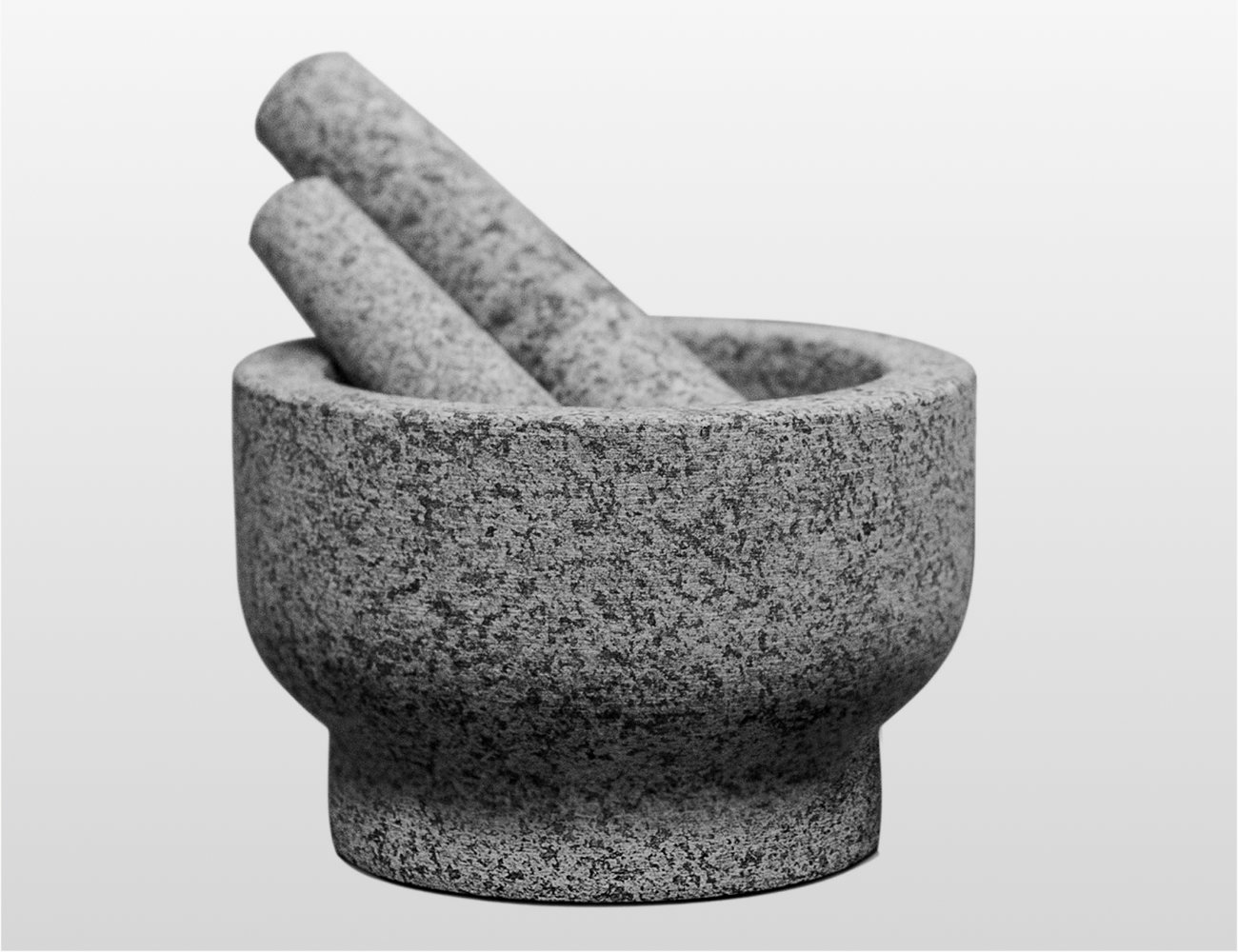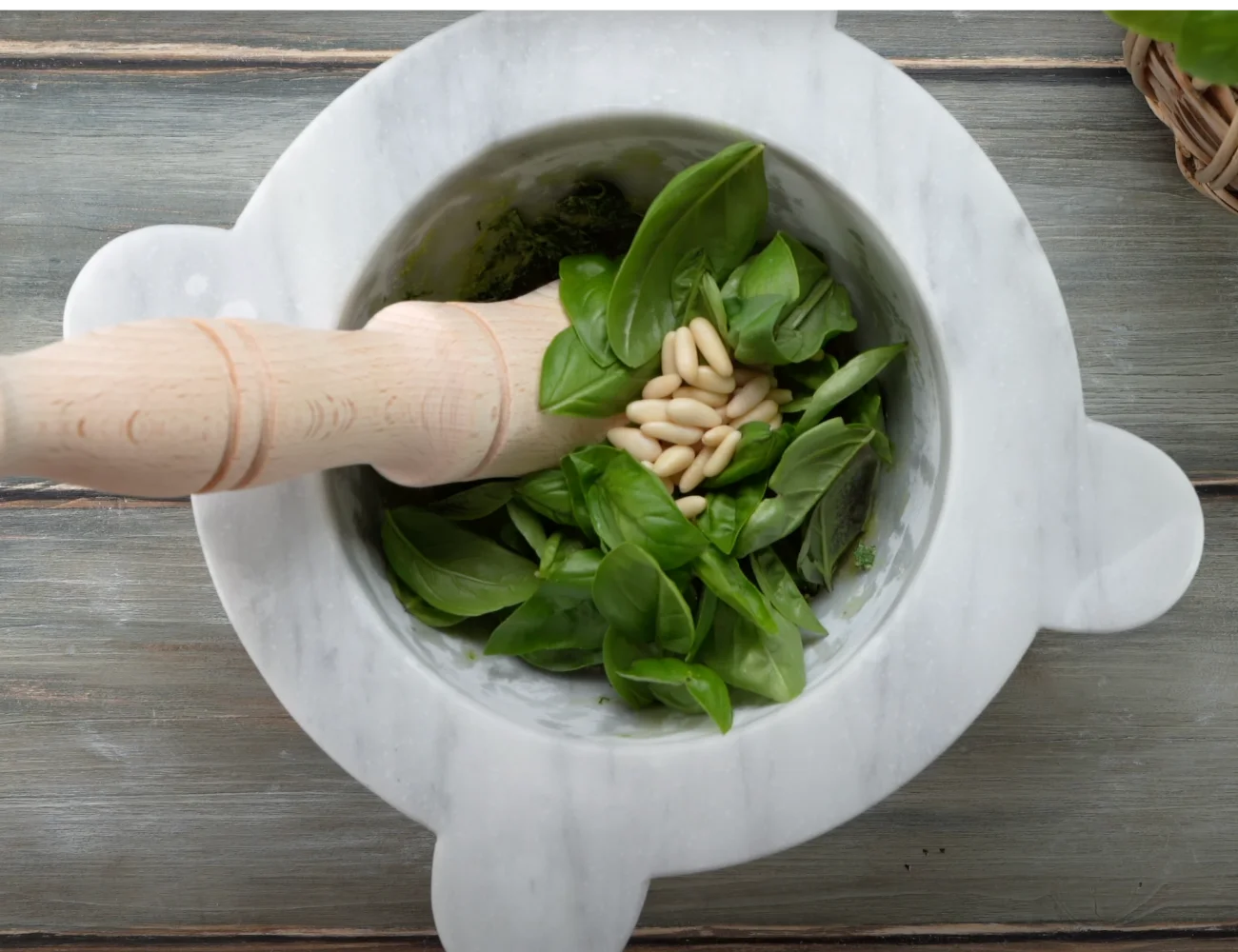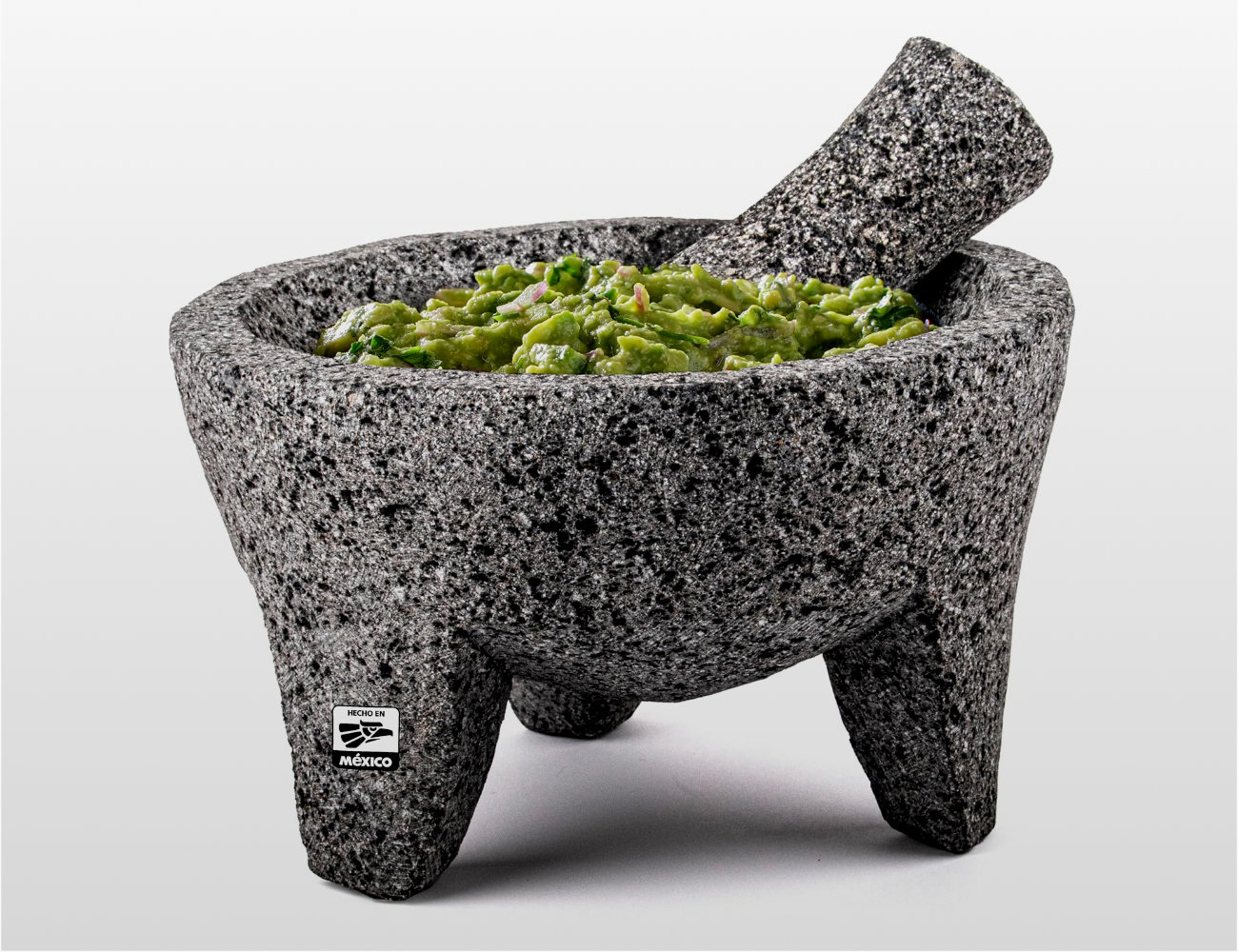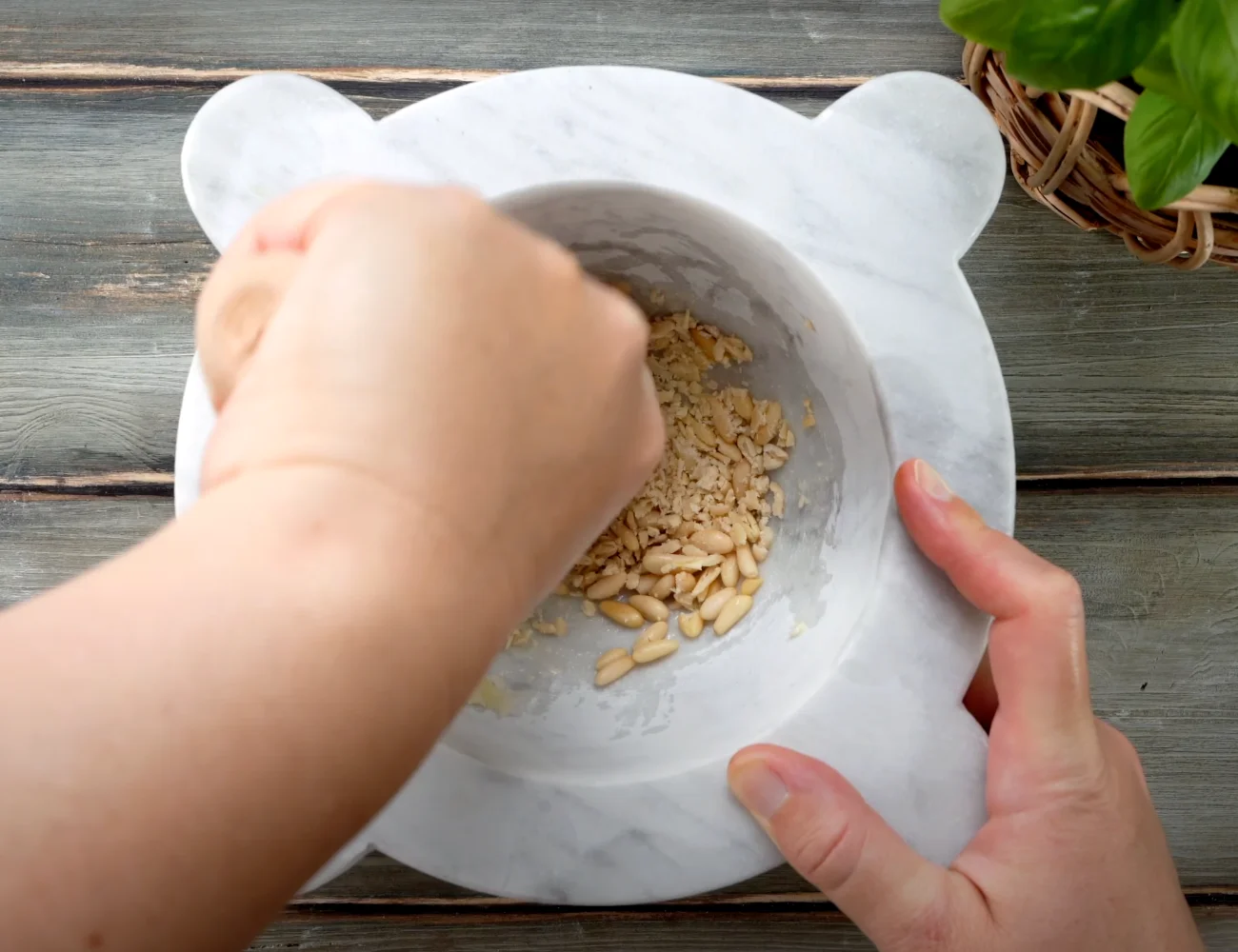Are you on a culinary quest to find the best mortar and pestle material? You’re not alone! This ancient kitchen tool is a staple in kitchens worldwide, and the material it’s made from can significantly affect its performance.
Let’s embark on a journey to evaluate various materials and discover why the best mortar and pestle might just be made in Italy!
Best Mortar Material: Criteria
The ‘mortar’ is the bowl of this tool. Here are the features we look for in mortar material:
- High Durability: Choose a material that is durable and can withstand repeated grinding and pounding without chipping or cracking. Granite, for instance, is known for its toughness.
- Rough Surface Texture: A slightly rough or coarse interior surface provides better friction for grinding, especially for hard ingredients like seeds and spices.
- Heavy Weight: A heavier mortar offers more stability and makes it easier to grind ingredients without it moving around. However, the weight should be manageable for you to handle comfortably.
- Large Size and Depth: Consider the size and depth of the mortar. It should be large enough for the quantities you typically prepare, and deep enough to prevent ingredients from spilling out.
- Less Porousness= Less Odor: Non-porous materials like granite are easier to clean and don’t absorb odors or flavors. If you choose a porous material like marble or ceramic, be aware that it may require more maintenance to prevent staining and flavor retention. NOTE: the best mortar materials usually are not dishwasher safe.
A heavier mortar will be more stable and less likely to move around or tip over while you’re grinding or pounding.
Mortar Material Winners? Granite and Marble
The ideal mortar should be durable and heavy. Granite and marble are that and more, offering a less porous surface than all of the other mortar materials. Marble is slightly more porous and slightly more prone to chipping than granite, but in our view the difference is negligible.
We recommend choosing a bowl at least 21 cm (around 8″). In our experience, this is the minimum size for versatility. After all, you aren’t going to just be grinding a few peppercorns with your new mortar and pestle, but making batches of pesto, guacamole and other traditional sauces and condiments best made with this traditional tool. Here are two products that meet the criteria (affiliate links):
► Granite Mortar and Pestle: https://amzn.to/48jJPV3 ► Italian White Carrara Marble with Pestle ('Made in Italy'): https://amzn.to/3UekWGt


Mortar Materials to Avoid: Wood and Ceramic
Wooden mortars add a rustic charm to your kitchen, but they’re best for lighter tasks like muddling herbs. They’re gentle on delicate ingredients and won’t cause bruising, ensuring the flavors are fresh and intact. The downside? They can absorb flavors and odors over time, aren’t the best choice for wet mixtures and are unsuited to many of the heavier tasks that we want a mortar for. The bowl is simply too lightweight.
Ceramic mortars are another lightweight option we’d avoid. They’re easy to clean and suitable for a variety of tasks, from grinding spices to making pesto. However, they are not as durable as granite or marble and are more prone to breaking and chipping. And again, in our view, lightweight= bad when it comes to picking the best mortar and pestle for all-purpose jobs.
Mortar Materials Alternatives: Volcanic Stone
Natural volcanic stone, often referred to as basalt or lava stone, is another material used for making mortars and pestles. It’s a better choice than wood or ceramic due to its rough texture, weight and durability. However, it is more porous than granite or marble which will make it more prone to absorb odors and require more maintenance. Honestly, we’ve never tried this mortar material for ourselves. If you can find a large bowl at a much better price than the more common marble or granite, it could be worth a try. Here’s one with excellent reviews on Amazon, the last we checked:
► Volcanic Stone Mortar and Pestle (Hand Carved in Mexico): https://amzn.to/3RNlQqh

Best Pestle Material: Criteria
The ‘pestle’ is the tool used with the bowl (mortar) to grind or mash the ingredients.
Some suggest that the pestle material should be compatible with the mortar material, recommending even that the pestle and mortar be made of the same material. For example, choose a product that pairs a granite pestle with a granite mortar. The thinking here is that the pestle won’t damage the mortar over time and provides more effective grinding.
In our experience however, there are other considerations that have led us away from choosing pestle/mortars made of the same material.
- Weight and Balance: A good pestle should have sufficient weight to aid in grinding without requiring excessive force. However, it shouldn’t be so heavy that it becomes unwieldy or tiring to use. The weight should feel balanced in your hand.
- Ergonomics: The pestle should fit comfortably in your hand. Look for a pestle with a shape and size that allows for a good grip, making it easy to maneuver and apply pressure.
- Surface Texture: The grinding end of the pestle should have a texture that is similar to the mortar’s interior. This texture helps in efficiently crushing and grinding ingredients. It should be rough enough to grip the ingredients but not so rough that it becomes difficult to clean.
- Non-Porous (if possible): While not as critical as for the mortar, a less porous material is preferable for ease of cleaning and to prevent absorption of flavors and odors.
- Length: The pestle should be long enough to reach comfortably into the mortar without your hand hitting the rim, but not so long that it becomes awkward to use.
Remember, the best pestle is one that feels right in your hand, matches your mortar, and suits the types of ingredients you most frequently grind. Personal preference plays a big role in determining which pestle material is best for you.
Pestle Material Winners? Wood
We’ve heard the arguments for using a pestle made from the same material as a mortar. But, in our experience, pestles made of granite or marble are not ergonomic to use because there is not enough friction between the pestle and mortar and they tend to be heavy, tiring the hand. Seriously, if you are using a pestle for 10 minutes straight to make, say, an Italian Pesto Genovese—it’s important that the pestle be light enough to withstand the marathon.
Here’s a quick summary of why we prefer wood pestles:
- Friction and Grip: Wood pestles often have a slightly rougher texture compared to polished stone pestles. This roughness can provide better grip and friction against the smooth surface of a marble or granite mortar, making it easier to crush and grind ingredients.
- Weight Distribution and Force Application: Wooden pestles are usually lighter than stone pestles, which can often make them easier to maneuver and handle, allowing for more controlled and precise application of force.
- Absorption of Shock and Vibration: Wood has natural shock-absorbing properties. When you’re pounding or grinding with a wooden pestle, it can absorb some of the vibrations, which might result in a more comfortable and controlled grinding experience.
- Material Composition and Wear: Over time, the interaction between a stone pestle and a stone mortar might lead to wear on both surfaces, potentially making them smoother and less effective. A wood pestle, on the other hand, is more likely to wear down itself rather than the mortar, maintaining the mortar’s effectiveness over time.
In conclusion, while stone-on-stone combinations offer durability and heft, wood pestles often provide better control, comfort, and efficiency due to their texture, weight, and shock absorption qualities. And that has been our experience with them.
In an ideal world, we would have a good wooden pestle for all-purpose uses and a heavier one matching the material of the mortar anytime we need to grind a particularly hard spice or nut. With a heavier pestle, you don’t need to apply as much force when grinding. The weight of the pestle does some of the work for you, which can be especially helpful for tougher grinding tasks.
But, if we have to choose a mortar and pestle combination, we think the best mortar and pestle is the one that combines a stone mortar with a wooden pestle for all of the reasons discussed.
What We Use: Italian Mortar of White Marble with a Wooden Pestle
After evaluating these materials, it’s clear that each has its strengths and weaknesses. But, if you’re looking for the best of the best, look no further than this exquisite ‘Made in Italy’ mortar and pestle. Crafted with precision and care, this mortar and pestle set combines durability, efficiency, and style.
Want to learn more?
► Read our article on 'The Best Mortar and Pestle is Made in Italy' or research this mortar and pestle for yourself on Amazon: https://amzn.to/47lIvQB

As an Amazon Associate, we earn from qualifying purchases. This means at no extra cost to you, PIATTO may earn a small commission if you click the links and make a qualifying purchase.

